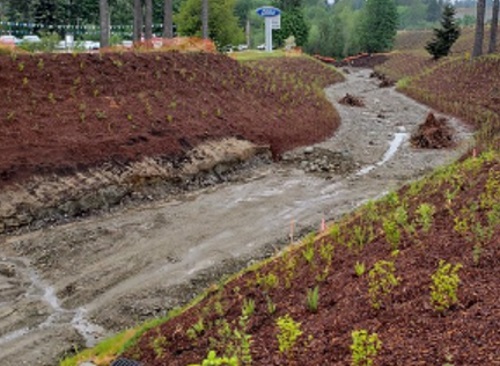If culverts under a busy state road are clogging a creek and preventing fish from migrating, how do you simultaneously replace the culverts, maintain traffic on the road, and protect the fish during construction?
[Above photo by WSDOT]
This riddle proved a real-life challenge for the Washington State Department of Transportation, which came up with an innovative answer – leave the culverts in place, build a new bridge somewhere else, and move the creek under it.
More than 50 years ago, the agency installed two 8-foot box culverts on State Route 3 over Chico Creek, home to the biggest chum salmon population in Kitsap County. In 2013, a federal court ruled that the abutting culverts were among 1,002 fish barriers in western Washington and ordered their removal by 2030.
The reason is that culverts create a “choke point” for fish – accumulating debris, narrowing the creek, and preventing thousands of salmon from making the annual spawning trek through the creek to the freshwater bay to lay their eggs. Above the creek, about 50,000 vehicles a day drive on SR 3, so a construction plan had to consider travel patterns of fish and motorists.
The WSDOT solution is a $58.3 million design-build project that features new bridges on SR 3 and nearby Chico Way, two realigned ramps, and two engineered creeks beneath the new bridges. The project will keep traffic and fish moving during and after construction.

Crews building a new SR 3 bridge just east of the culverts are simultaneously maintaining traffic volumes by shifting lanes toward the outside shoulders while the center portion of the bridge is constructed. Then traffic will shift again, to the inside shoulders, while the rest of the bridge is finished. Once SR 3 bridge construction is completed, crews will realign traffic lanes with the new bridge.
Meanwhile, crews are building an “engineered creek” that will realign Chico Creek to bypass the old culverts to pass under the new bridge. Construction work to redirect Chico Creek to the new channel will take place during “fish windows,” when construction work will do minimal damage to fish.
The engineered creek includes native vegetation, strategic bends, and elevation changes designed to support “every life cycle of fish,” said Doug Adamson, a WSDOT spokesman. It will feature places for fish to lay eggs and hide from predators, allowing the salmon to “naturally move” from fresh water to saltwater habitats and back again, Adamson said.
The project also includes a new bridge, two realigned ramps, and a second engineered creek at nearby Chico Way. This work will eliminate fish barriers to an unnamed tributary that feeds into Chico Creek by realigning the tributary and giving it a much wider channel under the new Chico Way Bridge.
The entire project, which will improve access to 21 miles of potential habitat, is regarded as one of the most significant fish barrier removal projects in western Washington due to the number of fish involved and because of the cultural impact to the Suquamish Tribe, whose ancestors have inhabited the area for thousands of years.
The project comes 30 years after WSDOT first created a dedicated program to remove barriers to fish under state highways. Since 1991, the agency has fixed 344 barriers, opening a total of 1,161 miles of fish habitat. “We are opening up dozens and dozens of miles for habitat for fish who couldn’t reach these areas since the highways were first built,” Adamson said. “We are making up for mistakes made in the past. We are working to rectify those mistakes to improve the habitat for native fish.”

